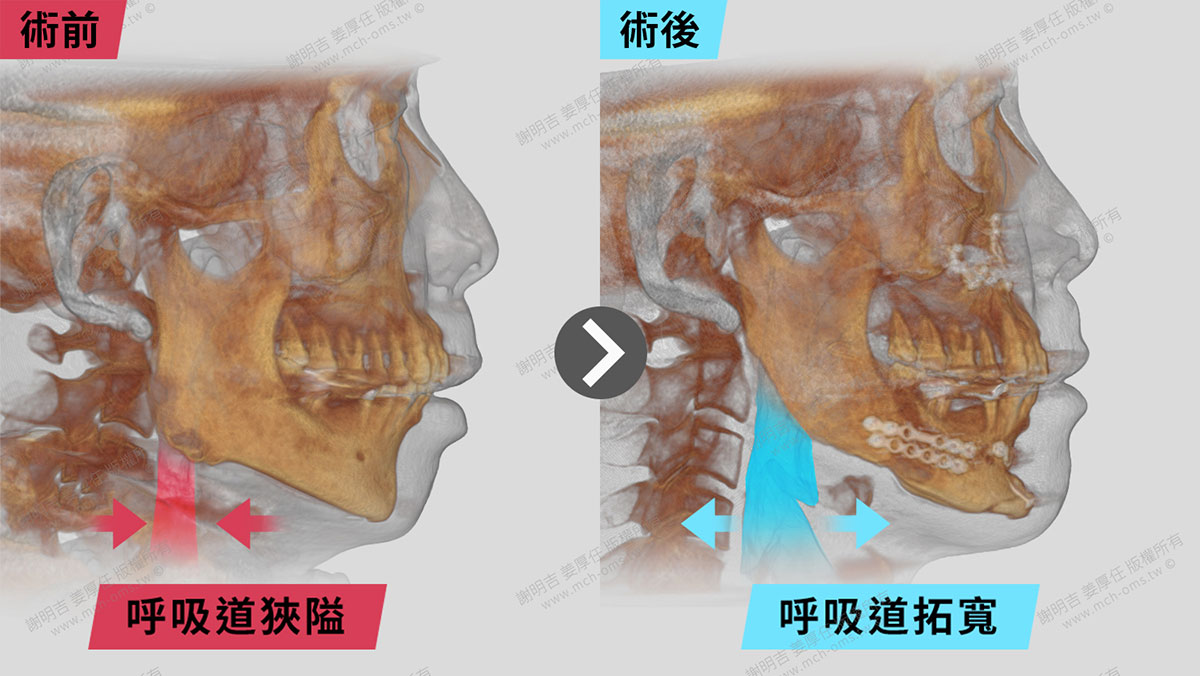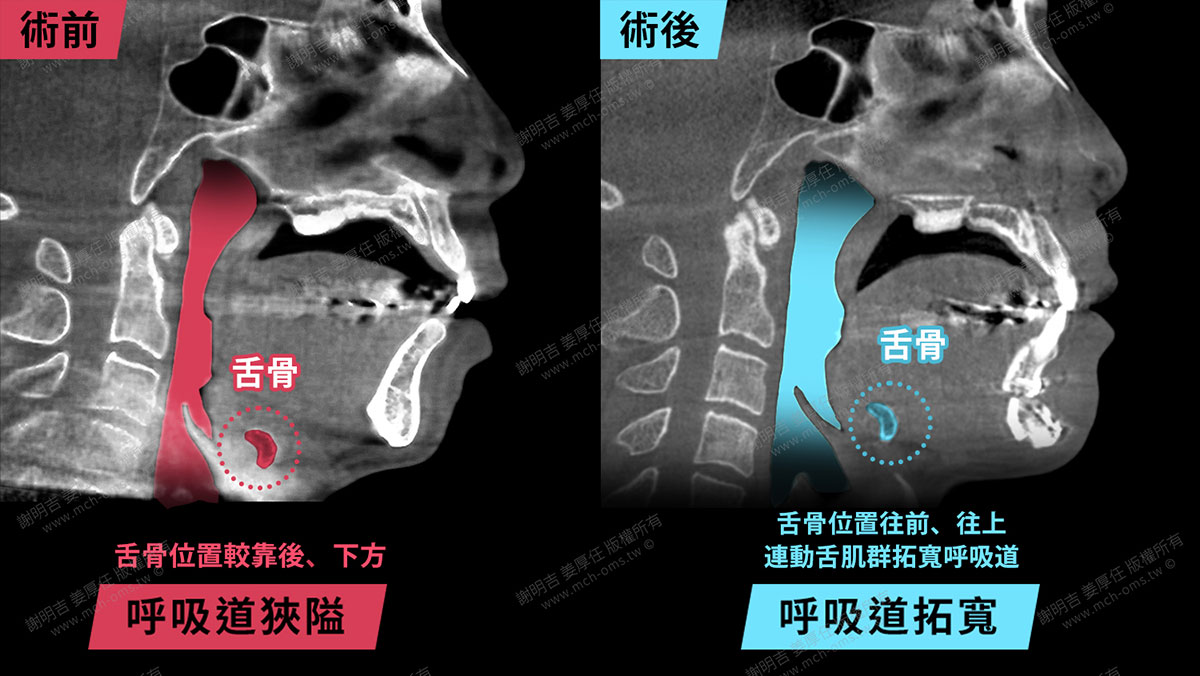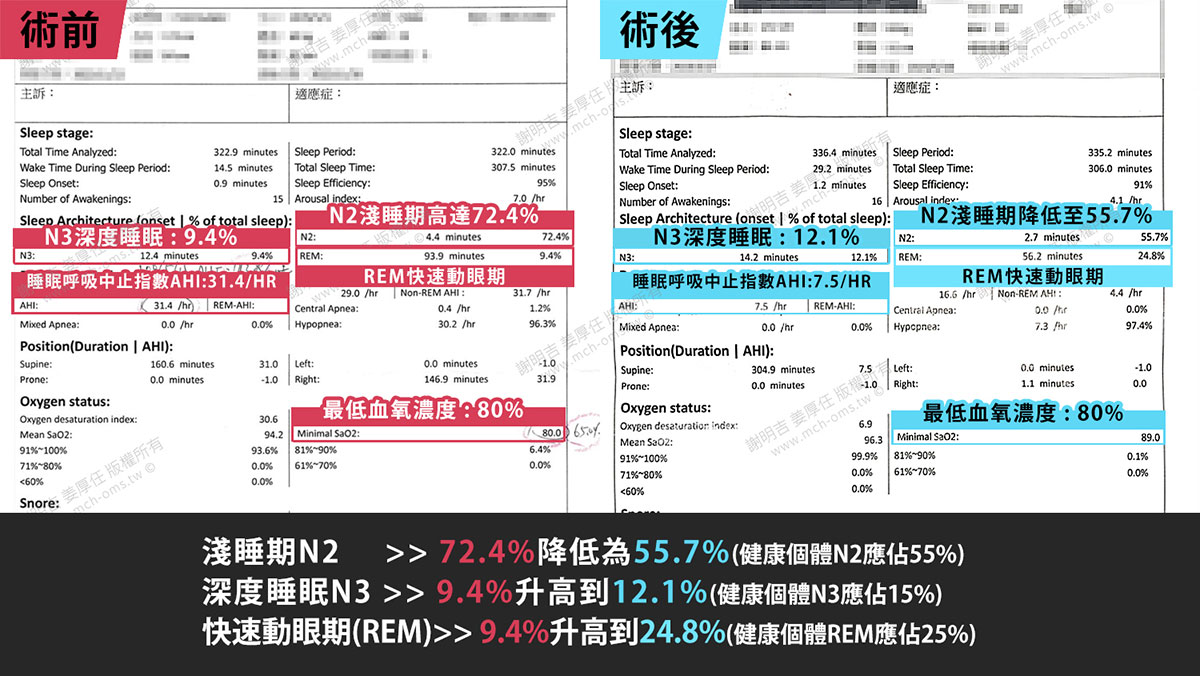| 術前症狀 | 手術計畫 |
| 重度睡眠呼吸中止症、情緒不佳、記憶退化以及認知功能障礙等臨床症狀。 | 拓寬呼吸道的正顎手術 |
一位很嗜睡的患者,帶著睡眠報告前來求診,報告顯示他是重度睡眠呼吸中止(AHI = 31.4 /hr),因為長期缺乏快速動眼期睡眠(REM sleep),他也出現了情緒不佳、記憶退化以及認知功能障礙等臨床症狀。
多年來,他先後嘗試了陽壓呼吸器及止鼾牙套,但這幾年有越來越無法適應的情況,會在睡眠中把這些幫助呼吸的輔助裝置自己移除,自然就沒有治療效果,
所以他希望能尋求較根除性的手術治療。我們為他執行了拓寬呼吸道的正顎手術(Maxillo-Mandibular Advancement)(MMA),
從電腦斷層上可以看到阻塞的位置(懸壅垂以及舌根),得到很好的打通及拓寬,舌骨的位置有很明顯向上以及向前的拉提。
術後的睡眠報告顯示,睡眠呼吸中止指數(AHI)由31.4/hr降為7.5/hr,最低血氧濃度由80%升高到89%,睡眠結構也更接近健康的個體,原則上,治療目標應該要減少淺睡期N2並且增加深度睡眠N3以快速動眼期(REM)的佔比,淺睡期N2由72.4%降低為55.7%(健康個體N2應佔55%),深度睡眠N3由9.4%升高到12.1%(健康個體N3應佔15%),最重要的,快速動眼期(REM)由9.4%升高到24.8%(健康個體REM應佔25%)。
因為深度睡眠的增加,這位患者手術後有比較睡飽充滿電的感覺,心情也比較陽光正面,生活及工作都更有活力。
A very drowsy patient came to us with his sleep report, which showed that he had severe obstructive sleep apnea (AHI = 31.4/hr). Due to prolonged lack of rapid eye movement (REM) sleep, he also exhibited clinical symptoms such as poor mood, memory decline, and cognitive dysfunction.
Over the years, he had tried using positive airway pressure device (CPAP) and oral appliance. In recent years,however, he has found it increasingly difficult to adapt to these devices, often removing them during sleep, resulting in ineffective treatment.
He decided to seek a more radical surgical treatment.We performed a Maxillo-Mandibular Advancement (MMA) surgery designed to enlarge and stabilize his airway from collapsing during sleep. The CT scan showed the sites of the obstruction (uvula and tongue base), and we achieved a good opening and widening of the airway. The hyoid bone was significantly lifted upward and pulled forward from the advanced lower jaw.
Post-operative sleep reports showed that the apnea-hypopnea index (AHI) decreased from 31.4/hr to 7.5/hr, the minimum blood oxygen saturation increased from 80% to 89%, and the sleep structure became much closer to that of healthy individuals. Our aim was to decrease the proportion of light sleep (N2) while to increase the amount of deep sleep (N3) and REM sleep. According to the post-op sleep report, the light sleep N2 decreased from 72.4% to 55.7% (N2 should account for only 55% in healthy individuals), deep sleep N3 increased from 9.4% to 12.1% (N3 should account for 15% in healthy individuals), and most importantly, the REM sleep stage increased from 9.4% to 24.8% (REM should account for 25% in healthy individuals).
Due to the increase in deep sleep, the patient felt more refreshed and energized after the surgery, with a more positive mood and more vitality in life and work.
手術前後對比照


手術前後指數變化






